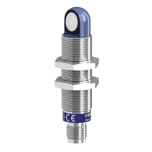Understanding the differences between Ultrasonic and Photoelectric technologies
Follow articleHow do you feel about this article? Help us to provide better content for you.
Thank you! Your feedback has been received.
There was a problem submitting your feedback, please try again later.
What do you think of this article?
 An Interview with Bobby Thomas
An Interview with Bobby Thomas
Ultrasonic sensors product manager at Telemecanique Sensors
In the industrial sensors market, ultrasonic technology seems to have a faster growth than other detection technologies in the last couple of years. Can you explain the high demand for this technology type?
Bobby Thomas (BT): In recent years, there has been a growing customer need for machine solutions which deal with the sensing of non-homogeneous materials. Ultrasonic sensors, using the Time of Flight principle, fill the gaps of the other industrial technologies such as that of inductive & photoelectric sensors. It is quite similar to the echo-location principle which is used by bats and dolphins for navigation. This is a reliable and precise technology.
How do you choose between a photoelectric sensor and an 
BT: Each sensing technology has its own strengths and weaknesses. Photoelectric sensors are excellent to detect objects within a few meters but they may not reliably sense black objects & there is a risk that the artificial lighting or sunlight may interfere with the sensing. An ultrasonic sensor can sense an object up to a few meters irrespective of the color or lighting conditions but they are weak in sensing sound-absorbent materials. And even with these known weaknesses in both technologies, there are economical solutions, like the reflex mode or the background suppression mode, to effectively detect the object.
You mentioned the Time of Flight principle. Can you explain this a bit more?
BT: An ultrasonic sensor sends out bursts of ultrasonic pulses and calculates the time taken for the echo to return after bouncing off the object. Using the speed of sound, the sensor calculates the distance from the object. This technology is comparable to the SONAR technology used in submarines. Historically, photoelectric sensors were used for simple detection of objects but today, there are some applicative photoelectric sensors which use the Time of Fight principle for distance measurement. (e.g. (133-6333)
What are the differences between an ultrasonic sensor and a photoelectric sensor which uses the Time of Flight principle?
BT: The Time of Flight photoelectric sensors have a small, bright laser spot to sense a small object or an object at a high angle of incidence. They have a quick response time and almost zero blind zone. Some typical applications include detecting fast moving packages or labels and precise position control of cranes. In contrast, ultrasonic sensors have a 3-dimensional detection zone – shaped like a cone – which makes it quite ideal for zone detection. Also, they can detect transparent objects, black objects and many liquids. Level measurement of liquids or solids, transparent bottle detection and collision detection are typical applications of ultrasonic sensors.
Are these sensors “Simply easy!” to setup and use?
BT: Yes. The initial setup is done through a builtin pushbutton or accessory with the help of 
ideal for detecting smaller objects such as semiconductor boards or thin films.
Can you describe the Time of Flight sensors offered by Telemecanique Sensors?
BT: Our compact photoelectric Time of Flight by Telemecanique Sensors can directly sense an object up to a distance of 5 meters and up to 70 meters when using a reflector as the target. Our ultrasonic range “OsiSense XX” are used for customer applications which involve simple detection or measurement from a distance of 5 cm up to 8 metres. The sensors also come in various shapes & sizes depending on installation requirements. And we are presently working on the next generation of ultrasonic sensors with a higher sensitivity, better reliability in detection & better immunity to electromagnetic interference. We are also launching a configuration software to program these sensors for more challenging applications. Stay tuned! Visit our company website to know more!

